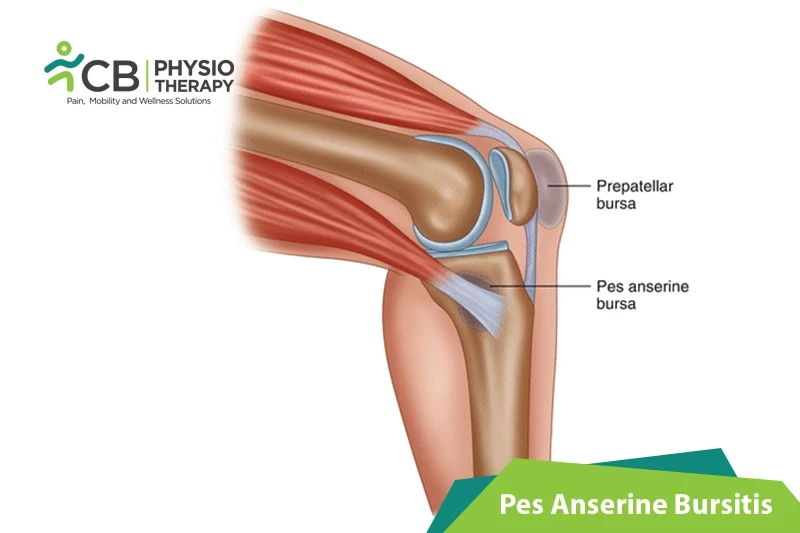
Pes anserine bursitis is an inflammation of the bursa located between the shinbone and the three tendons of the hamstring muscle at the inner side of the knee. It occurs when the bursa becomes irritated and produces excessive fluid, which causes it to swell and puts pressure on the adjacent parts of the knee. There is inflammation of the pes anserine bursa, causing pain and tenderness on the inside of the knee, approximately 2 to 3 inches below the joint. Pes anserinus means goose's foot and it gets its name from the webbed-foot shape made by the three tendons where they join together forming one tendon and attaching to the shin bone. Underneath this conjoined tendon is the pes anserine bursa, a small sac filled with fluid.
Sartorius: Is the longest muscle in the body that runs across and down the front of the thigh. It helps to bend the knee and hip.
Gracilis: Is a hip adductor (draws the leg inwards).
Semitendinosus: This is one of the 3 hamstring muscles that work together to bend the knee.
Symptoms of bursitis can be seen gradually rather than suddenly. People often complain it hurts more when they exercise or go upstairs, with resisted knee flexion or when they stretch their hamstrings, most common symptoms of pes anserine bursitis are:
Pathology:
Pes anserine bursitis Is also known as intertendinous bursa, it is an inflammation of the bursa of the conjoined insertion of the M. Sartorius, M. Gracilis, and M. Semitendinosus muscles along the proximal medial aspect of the tibia, the bursa is located approximately two inches below the medial knee joint line between the pes anserine tendons. When there is more pressure in the area of insertion of the pes anserinus it causes an increase in the release of synovial fluid in the lining of the bursa. The bursa then becomes inflamed and painful.
Friction over the area results in inflammation of the pes anserine bursa, which produces excessive fluid and thus swells, placing pressure on the surrounding structures. Several other factors can contribute to the development of pes anserine bursitis, including:
Physical Examination
The examiner does the physical examination of the knee, for diagnosis.
X-ray:
X-ray is used to rule out the other bony problems.
Magnetic resonance imaging (MRI):
Magnetic resonance imaging (MRI) is done to see the extent of external derangement of the knee.
Bone scan:
The bone scan is done to identify the stress fractures if any in the joint.
Additional test:
Erythrocyte sedimentation rate, blood cell count, and antinuclear anti-body test are recommended.
Medication: Non-steroidal anti-inflammatory medication such as aspirin, ibuprofen, naproxen, anesthetic injections, steroid, etc.
Note: Medication should not be taken without the doctor's prescription.
Surgery:
Patients who do not respond to conservative treatments are recommended surgery like bursectomy.
Rest:
Rest is really important to avoid activities that cause pain. This requires modifying the activities or completely taking rest to allow the swelling to settle down.
Apply ice at regular intervals three or four times a day for 20 minutes at a time, to the inner side of the knee. Ice therapy helps to reduce pain and swelling associated with pes anserine bursitis.
Therapeutic ultrasound helps to reduce the inflammatory process.
Transcutaneous electrical stimulation (TENS):
Transcutaneous electrical stimulation (TENS) can also be given to reduce pain.
Low-level laser therapy:
Low-level laser therapy can be used to have a healing effect on the inflamed bursa.
Massage therapy is used to regain mobility and increase knee range of motion.
Strengthening exercises can be done to decrease tightness, and improve strength and endurance. These exercises include isometric hamstrings, quadriceps, gluteus, and straight leg raises. The exercises are progressed further to single knee dips, squats, leg presses, and lunges resisted leg pulls using elastic tubing are also included.
Stretching exercises:
Stretching exercises are done to increase the range of motion and increase flexibility. These exercises can be stretching of quadriceps, sartorius, and semitendinosus, calf stretches, seated adductor stretch,
Activity modification:
Initial treatment starts with activity modification like modification of activities such as reducing the duration, intensity, and frequency of running. Weight loss is another important factor. Use of pillows between the thighs at night is strongly recommended.
In case of surgery, the patient is advised to slowly return to normal activities and to take care, not to push things too much too quickly. The patient is advised for non-weight bearing exercises such as cycling or swimming initially and then return to short distances alternating between running and walking. But should be advised not to ignore pain while doing an activity, or later during the day allow to take adequate rest.
Select your City to find & connect with our experts regarding Physiotherapy for Pes Anserine Bursitis